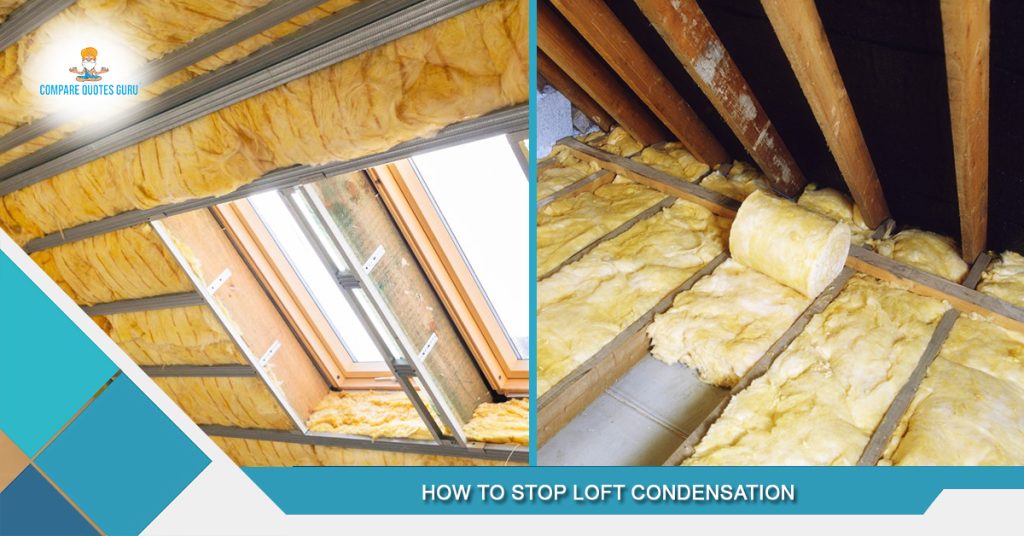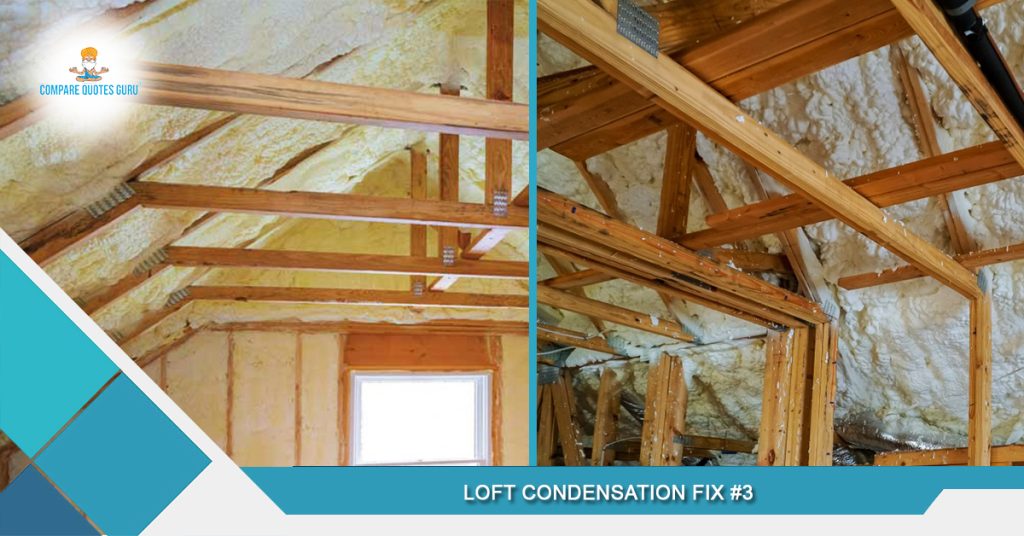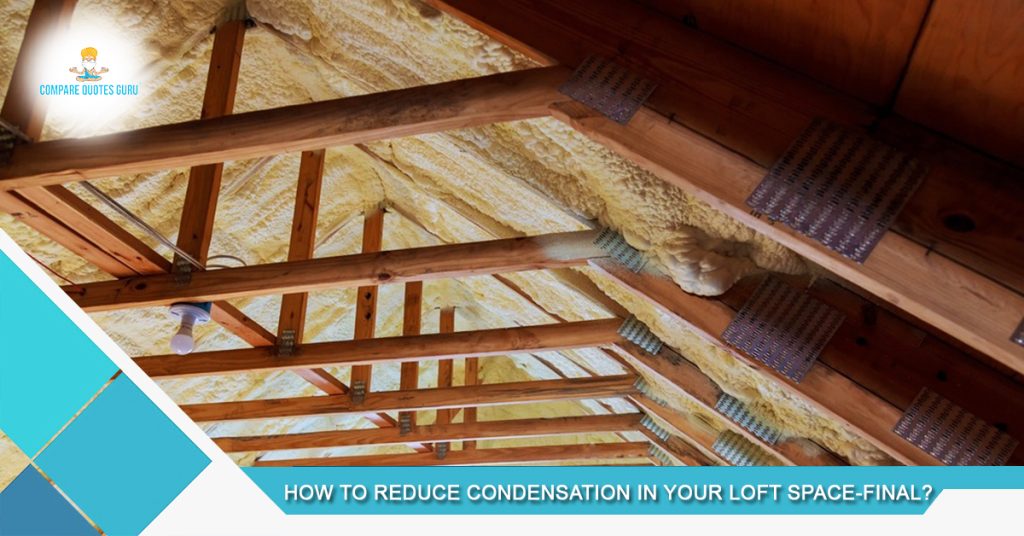Loft Condensation
How often do you think about the condition of your loft? The answer is probably not much unless you are a qualified builder with expertise. The trouble is that without proper knowledge in the condition of your loft, it will probably lead to timber rot which can be expensive to repair. Of course, repairing timber rot still does not solve the problem.
If you don’t shore up your defenses against loft condensation you will simply have to repair the timber periodically. A smarter option is to treat the core issue, the circulation of air in your loft. To do this effectively you need to know a few things. You need to know how loft condensation forms and what resources you have at your disposal. Read on to find out more.
What Causes Loft Condensation
Condensation in the loft happens when humid air creeps between badly fitted insulation. It meets the cold air on the inside roof tiles and turns to water droplets. A loft space is a small area that is usually made of timber and doesn’t get much attention. These are ideal conditions for timber rot.
Condensation in the loft space is also created by badly fitted loft hatches and poor insulation. The gaps formed in the hatches and through the insulation allows moisture to occupy the loft space. As the moisture warms and rises it meets the cold roof tiles. You may notice some dampness on the wall or a small water pool on the floor of the loft.
Many modern homes now use special ventilation to avoid the worst effects of loft condensation. This ventilation allows air to circulate freely through the eaves and ridge. Unfortunately, most older homes do not have this design and ventilate the loft through the tile vents. To minimize the worst effects of loft condensation, we need air circulations as much as possible. This can be done by reducing loft clutter.
How to Stop Condensation in Loft

Best time to see the appearance of loft condensation in your home is in the autumn and winter. This is when the air outside is coldest meaning the warm air in your loft condenses against the cold roof tiles. At this time of the year, you may notice small pools of water on your loft floor, or blackness in the walls.
Most older homes are not well equipped to handle loft condensation which is why you need to make every effort to minimise that chances of timber rot and costly building work. Broadly, main ways to prevent loft condensation are to insulate your loft effectively and create better air circulation in the loft space.
In this article we look at three common ways you can prevent loft condensation from ruining your timber. The first is spray foam insulation cost uk, the second is foam boards, and the third is tile vents. Regardless of which option you choose it is still advisable to create better circulation in you loft by removing boxes.
Loft Condensation Fix #1
Condensation in your loft happens in two ways. There is condensation, and there is interstitial condensation. The difference is in where and how the condensation forms. Ordinary condensation is formed on the outside of the structure, whereas interstitial condensation occurs on the inside.
If you have a timber frame loft construction, you will probably be familiar with water droplets and dampness of the timber. This is ordinary condensation which occurs when the cold air from outside contacts with the cold timbers. The temperature of the air is reduced to its ‘dew’ point causing dampness.
Interstitial condensation is slightly different. This occurs when the cold air penetrates the timber in the loft construction and causes dampness within the wood. The big advantage of Spray Foam insulation is that it prevents both types of condensation from occurring.
Loft Condensation Fix #2
For a low-cost option to fix the condensation problem in your loft, you might consider Foam Panel Insulation. Foam panels are typically made from polystyrene, polyisocyanurate, or polyurethane. They can be obtained as either rolls, panels, or batts. They are usually made of fiberglass but can come in other materials such as rock, wool, plastic, and natural fibers.
As they are relatively inexpensive, foam boards are not as effective at reducing loft condensation as spray foam insulation. If you think that foam panels are the quick-fire solution, think again, they do have some drawbacks.
Foam boards are made up for plastic and fibers that can cause indoor air pollution and sag over time making them ineffective. Foam board insulation can also be tricky to fit. You must measure the exact dimensions and line them up perfectly to prevent any leakage. Also, because the foam boards are often made from fiberglass cutting and fitting them can be awkward work that presents a health hazard.
Loft Condensation Fix #3

The final way to prevent damaging loft condensation is to install roof vents. Roof vents come in two types: gable vents and ridge vents. They are usually installed at various points on your roof to help with the circulation of moisture laden air. Rather than preventing the intake of cold air, vents help move it along.
Venting your loft can be a mean of preventing loft condensation. A Soffit vent will first encourage cold air into the loft space while a roof or gable vent – located higher up – draws the cold air up and back outside. This constant movement of air throughout the loft prevents dew droplets forming and causing rot.
Once again, installing roof vents is not a silver bullet for solving the condensation issue. If you only install one type of vent, such as a Soffit or a Gable, you may need up with trapped cold air in pockets of the loft that will lead to damage. Furthermore, you may not get the results you expect if you install too many vents on a small roof area.
When do People Need Condensation Solutions for their Loft Space?
Condensation can accumulate at any time of the year, but it is most frequent in the autumn and winter seasons.
Patches of dampness, moisture accumulation on the insides of windows, or nasty black spots on your walls are the first indicators of the requirement for condensation solution in your loft area.
Mould spores may also form on sheets or other objects kept in your loft in more severe situations.
If you discover any of these stated problems, it is critical that you address them as soon as possible or deduce any effective condensation solutions.
Damp and mould pose serious health dangers, and if left uncontrolled, excess moisture can erode away at the wooden beams in your roof.
Condensation in Loft Space is especially more recurrent in those homes that recently have a modern loft constructed in their homes.
Condensation can not only cause considerable structural damage, specifically to wood parts on your property, but it can also be hazardous to your health.
Get Our Expert’s Help For Condensation in your Loft Space
It is suggested to take assistance from insulation experts when you witness even patches of condensation in your loft space.
As we improve the insulation in our homes, we must also improve ventilation to deal with the surge in warm air within the property and avoid condensation.
As per the insulation experts, avoid drying clothes indoors as drying garments indoors can increase condensation levels by up to 30%.
If your loft space is already protected or properly insulated, check to ensure it has not been harmed by dampness, pests, or other problems.
It should be replaced with breathable loft insulation and a vapour barrier to prevent moisture infiltration and condensation problems.

